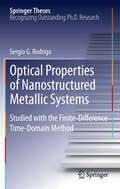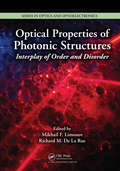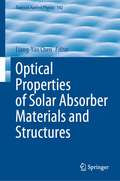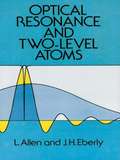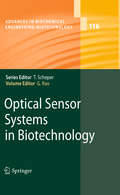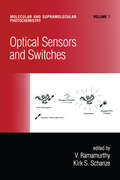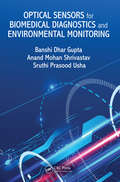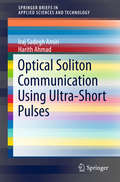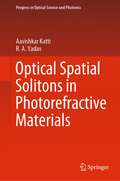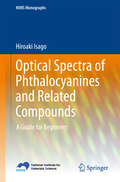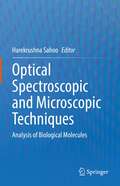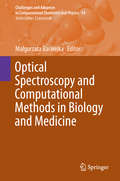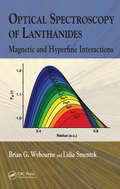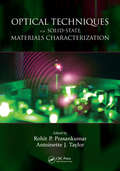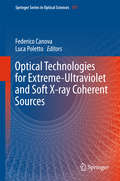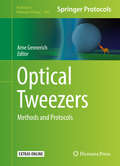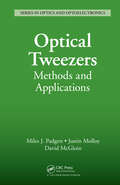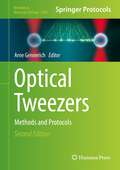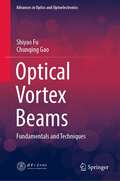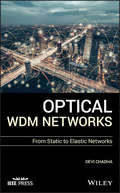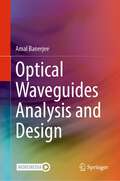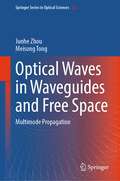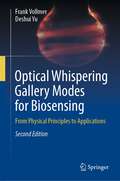- Table View
- List View
Optical Properties of Nanostructured Metallic Systems
by Sergio G. RodrigoThe common belief is that light is completely reflected by metals. In reality they also exhibit an amazing property that is not so widely known: under some conditions light flows along a metallic surface as if it were glued to it. Physical phenomena related to these light waves, which are called Surface Plasmon Polaritons (SPP), have given rise to the research field of plasmonics. This thesis explores four interesting topics within plasmonics: extraordinary optical transmission, negative refractive index metamaterials, plasmonic devices for controlling SPPs, and field enhancement phenomena near metal nanoparticles.
Optical Properties of Photonic Structures: Interplay of Order and Disorder
by Richard M. De La Rue Mikhail F. LimonovThe collection of articles in this book offers a penetrating shaft into the still burgeoning subject of light propagation and localization in photonic crystals and disordered media. While the subject has its origins in physics, it has broad significance and applicability in disciplines such as engineering, chemistry, mathematics, and medicine. Unli
Optical Properties of Solar Absorber Materials and Structures (Topics in Applied Physics #142)
by Liang-Yao ChenThis book presents an overview of both the theory and experimental methods required to realize high efficiency solar absorber devices. It begins with a historical description of the study of spectrally selective solar absorber materials and structures based on optical principles and methods developed over the past few decades. The optical properties of metals and dielectric materials are addressed to provide the background necessary to achieve high performance of the solar absorber devices as applied in the solar energy field. In the following sections, different types of materials and structures, together with the relevant experimental methods, are discussed for practical construction and fabrication of the solar absorber devices, aiming to maximally harvest the solar energy while at the same time effectively suppressing the heat-emission loss. The optical principles and methods used to evaluate the performance of solar absorber devices with broad applications in different physical conditions are presented. The book is suitable for graduate students in applied physics, and provides a valuable reference for researchers working actively in the field of solar energy.
Optical Resonance and Two-Level Atoms
by L. Allen J. H. Eberly"Coherent and lucid...a valuable summary of a subject to which [the authors] have made significant contributions by their own research." -- Contemporary PhysicsOffering an admirably clear account of the basic principles behind all quantum optical resonance phenomena, and hailed as a valuable contribution to the literature of nonlinear optics, this distinguished work provides graduate students and research physicists probing fields such as laser physics, quantum optics, nonlinear optics, quantum electronics, and resonance optics an ideal introduction to the study of the interaction of electromagnetic radiation with matter.The book first examines the applicability of the two-level model for atoms to real atoms, then explores semiclassical radiation theory, and derives the optical Bloch equations. It then examines Rabi inversion, optical nutation, free-induction decay, coherent optical transient effects, light amplification, superradiance, and photon echoes in solids and gases.Before the publication of this book, much of the material discussed was widely scattered in other books and research journals. This comprehensive treatment brings it together in one convenient resource. The style of writing is clear and informal and the emphasis throughout is always on the physics of the processes taking place. There are numerous helpful illustrations, excellent introductions to each chapter, and lists of references for further reading."The authors have endeavored to create a primer for the field of optical resonance...they have succeeded admirably. Their coverage of the subject is remarkably complete." -- IEEE Journal of Quantum Electronics
Optical Sensor Systems in Biotechnology
by Govind RaoOptical Sensor Systems in Biotechnology covers trends in this modern biotechnology. The book treats all aspects of this interdisciplinary technology, where knowledge, methods and expertise are required from a broad range of disciplines.
Optical Sensors and Switches
by V. Ramamurthy Kirk S. SchanzeA consideration of the development of photochemical systems with functions as optical sensors or switches, discussing materials and chemical systems, technology, and applications for target molecules and optical signal multiplexing. It contains novel applications in electrogenerated chemiluminescence and supramolecular photophysics for sensing chem
Optical Sensors for Biomedical Diagnostics and Environmental Monitoring
by Banshi Dhar Gupta Anand Mohan Shrivastav Sruthi Prasood UshaThe field of plasmonics has shown extraordinary capabilities in realizing highly sensitive and accurate sensors for environmental monitoring and measurement of biological analytes. The inherent potential of such devices has led to growing interest worldwide in commercial fiber optic chemical and biosensors. Optical Sensors for Biomedical Diagnostics and Environmental Monitoring is an essential resource for students, established researchers, and industry developers in need of a reference work on both the fundamentals and latest advances in optical fiber sensor technology in biomedical diagnostics and environmental monitoring. The book includes rigorous theory and experimental techniques of surface plasmon and lossy mode resonances, as well as real-time sensing applications of resonance techniques implemented over optical fiber substrate using bulk layer and/or nanostructures as transducer and sensing layers. In addition, discussion of various design options for real-time sensors in environmental monitoring and biomedical diagnostics make the book approachable to readers from multidisciplinary fields.
Optical Soliton Communication Using Ultra-Short Pulses
by Iraj Sadegh Amiri Harith AhmadThis brief analyzes the characteristics of a microring resonator (MRR) to perform communication using ultra-short soliton pulses. The raising of nonlinear refractive indices, coupling coefficients and radius of the single microring resonator leads to decrease in input power and round trips wherein the bifurcation occurs. As a result, bifurcation or chaos behaviors are seen at lower input power of 44 W, where the nonlinear refractive index is n2=3. 2×10−20 m2/W. Using a decimal convertor system, these ultra-short signals can be converted into quantum information. Results show that multi solitons with FWHM and FSR of 10 pm and 600 pm can be generated respectively. The multi optical soliton with FWHM and FSR of 325 pm and 880 nm can be incorporated with a time division multiple access (TDMA) system wherein the transportation of quantum information is performed.
Optical Spatial Solitons in Photorefractive Materials (Progress in Optical Science and Photonics #14)
by Aavishkar Katti R.A. YadavThis book highlights recent advances of optical spatial solitons in photorefractive materials ranging broadly from the coupling, modulation instability, effect of pyroelectricity, and the stability of photorefractive solitons, among other topics. Photorefractive solitons have been at the forefront of research because of their formation at low laser powers and unique saturable nonlinearity present in photorefractive materials which supports solitons in (2+1) D. There has been a spurt in research on photorefractive solitons recently, which has contributed to a greater understanding of the theoretical foundation of photorefractive solitons as also of their various interesting and practical applications. The book elucidates the diversity of photorefractive solitons and provides a good resource for students, researchers, and professionals in the area of nonlinear optics.
Optical Spectra of Phthalocyanines and Related Compounds
by Hiroaki IsagoThis book displays how optical (absorption, emission, and magnetic circular dichroism) spectra of phthalocyanines and related macrocyclic dyes can be varied from their prototypical ones depending on conditions. As these compounds can be involved in colorful chemistry (which might be driven by impurities in solvents), their spectra behave like the sea-god Proteus in their mutability. Therefore, those who have been engaged with phthalocyanines for the first time, including even educated professional researchers and engineers, may have been embarrassed by the deceptive behavior of their compounds and could have, in the worst cases, given up their projects. This book is aimed not merely at reviewing the optical spectra, but also at helping such people, particularly beginners, to figure them out by showing some examples of their prototypical spectra and their variations in several situations. For the purpose of better understanding, the book also provides an introduction to their theoretical backgrounds as graphically as possible and without mathematicization for readers who are weak in mathematics.
Optical Spectroscopic and Microscopic Techniques: Analysis of Biological Molecules
by Harekrushna SahooThis book illustrates the significance of various optical spectroscopy and microscopy techniques, including absorption spectroscopy, fluorescence spectroscopy, infrared spectroscopy, and Raman spectroscopy for deciphering the nature of biological molecules. The content of this book chiefly focuses on (1) the principle, theory, and instrumentation used in different optical spectroscopy techniques, and (2) the application of these techniques in exploring the nature of different biomolecules (e.g., proteins, nucleic acids, enzymes, and carbohydrates). It emphasizes the structural, conformational and dynamic, and kinetic including the changes in biomolecules under a range of conditions. In closing, the book summarizes recent advances in the field of optical spectroscopic and microscopic techniques.
Optical Spectroscopy and Computational Methods in Biology and Medicine
by Malgorzata BaranskaThis multi-author contributed volume gives a comprehensive overview of recent progress in various vibrational spectroscopic techniques and chemometric methods and their applications in chemistry, biology and medicine. In order to meet the needs of readers, the book focuses on recent advances in technical development and potential exploitations of the theory, as well as the new applications of vibrational methods to problems of recent general interest that were difficult or even impossible to achieve in the not so distant past. Integrating vibrational spectroscopy and computational approaches serves as a handbook for people performing vibrational spectroscopy followed by chemometric analysis hence both experimental methods as well as procedures of recommended analysis are described. This volume is written for individuals who develop new methodologies and extend these applications to new realms of chemical and medicinal interest.
Optical Spectroscopy of Lanthanides: Magnetic and Hyperfine Interactions
by Brian G. Wybourne Lidia SmentekOptical Spectroscopy of Lanthanides: Magnetic and Hyperfine Interactions represents the sixth and final book by the late Brian Wybourne, an accomplished pioneer in the spectroscopy of rare earth ions, and Lidia Smentek, a leading theoretical physicist in the field. The book provides a definitive and up-to-date theoretical description of spec
Optical Techniques for Solid-State Materials Characterization
by Rohit P. Prasankumar Antoinett E J. TaylorOver the last century, numerous optical techniques have been developed to characterize materials, giving insight into their optical, electronic, magnetic, and structural properties and elucidating such diverse phenomena as high-temperature superconductivity and protein folding. Optical Techniques for Solid-State Materials Characterization provides
Optical Techniques in Regenerative Medicine
by Stephen P. Morgan Felicity R. A. J. Rose Stephen J. MatcherIn regenerative medicine, tissue engineers largely rely on destructive and time-consuming techniques that do not allow in situ and spatial monitoring of tissue growth. Furthermore, once the therapy is implanted in the patient, clinicians are often unable to monitor what is happening in the body. To tackle these barriers, optical techniques have bee
Optical Technologies for Extreme-Ultraviolet and Soft X-ray Coherent Sources
by Federico Canova Luca PolettoThe book reviews the most recent achievements in optical technologies for XUV and X-ray coherent sources. Particular attention is given to free-electron-laser facilities, but also to other sources available at present, such as synchrotrons, high-order laser harmonics and X-ray lasers. The optical technologies relevant to each type of source are discussed. In addition, the main technologies used for photon handling and conditioning, namely multilayer mirrors, adaptive optics, crystals and gratings are explained. Experiments using coherent light received during the last decades a lot of attention for the X-ray regime. Strong efforts were taken for the realization of almost fully coherent sources, e. g. the free-electron lasers, both as independent sources in the femtosecond and attosecond regimes and as seeding sources for free-electron-lasers and X-ray gas lasers. In parallel to the development of sources, optical technologies for photon handling and conditioning of such coherent and intense X-ray beams advanced. New problems were faced for the realization of optical components of beamlines demanding to manage coherent X-ray photons, e. g. the preservation of coherence and time structure of ultra short pulses.
Optical Tweezers
by Arne GennerichThe aim of this volume is to provide a comprehensive overview of optical tweezers setups, both in practical and theoretical terms, to help biophysicists, biochemists, and cell biologists to build and calibrate their own instruments and to perform force measurements on mechanoenzymes both in isolation in vitro and in living cells. Chapters have been divided in three parts focusing on theory and practical design of optical tweezers, detailed protocols for performing force measurements on single DNA- and microtubule/actin-associated mechanoenzymes in isolation, and describing recent advances that have opened up quantitative force measurements in living cells. Written in the highly successful Methods in Molecular Biology series format, chapters include introductions to their respective topics, lists of the necessary materials and reagents, step-by-step, readily reproducible laboratory protocols, and tips on troubleshooting and avoiding known pitfalls. Authoritative and cutting-edge, Optical Tweezers: Methods and Protocols aims help to further expand the accessibility and use of optical traps by scientists of diverse disciplines.
Optical Tweezers: Methods and Applications
by Miles J. Padgett Justin E. Molloy David McGloinThe technical development of optical tweezers, along with their application in the biological and physical sciences, has progressed significantly since the demonstration of an optical trap for micron-sized particles based on a single, tightly focused laser beam was first reported more than twenty years ago. Bringing together many landmark papers on
Optical Tweezers: Methods and Protocols (Methods in Molecular Biology #2478)
by Arne GennerichThis detailed volume explores a wide variety of techniques involving optical tweezers, a technology that has become increasingly more accessible to a broad range of researchers. Beginning with recent technical advances, the book continues by covering the application of optical tweezers to study DNA-protein interactions and DNA motors, protocols to perform protein (un)folding experiments, the application of optical tweezers to study actin- and microtubule-associated motor proteins, and well as protocols for investigating the function and mechanical properties of microtubules and intermediate filaments, and more. Written for the highly successful Methods in Molecular Biology series, chapters include introductions to their respective topics, lists of the necessary materials and reagents, step-by-step, readily reproducible laboratory protocols, and tips on troubleshooting and avoiding known pitfalls. Authoritative and practical, Optical Tweezers: Methods and Protocols, Second Edition serves as an ideal resource for expanding the accessibility and use of optical traps by scientists of diverse disciplines.
Optical Vortex Beams: Fundamentals and Techniques (Advances in Optics and Optoelectronics)
by Shiyao Fu Chunqing GaoThis book focuses on optical vortices, including beams carrying orbital angular momentum and vector beams. It presents an overview of, and the latest research on this novel type of optical beam, which is a hot topic in the domain of modern optics, especially in optical communication and beam manipulation. Summarizing the fundamentals of optical vortices, it discusses their characterization and propagation, and focuses on the generation of vortices such as vortex-arrays, and the detection of vortices and their orbital angular momentum state. It also comprehensively examines the adaptive compensation systems, as well as vector beams and polarization vortices with anisotropic polarization distributions. Further it provides a detailed description of perfect vortices with beam diameters independent of the angular momentum. This book is intended for researchers, engineers and graduate students working in the field of optics and laser beam applications.
Optical WDM Networks: From Static to Elastic Networks (Wiley - IEEE)
by Devi ChadhaProvides a comprehensive and updated account of WDM optical network systems Optical networking has advanced considerably since 2010. A host of new technologies and applications has brought a significant change in optical networks, migrating it towards an all-optical network. This book places great emphasis on the network concepts, technology, and methodologies that will stand the test of time and also help in understanding and developing advanced optical network systems. The first part of Optical WDM Networks: From Static to Elastic Networks provides a qualitative foundation for what follows—presenting an overview of optical networking, the different network architectures, basic concepts, and a high-level view of the different network structures considered in subsequent chapters. It offers a survey of enabling technologies and the hardware devices in the physical layer, followed by a more detailed picture of the network in the remaining chapters. The next sections give an in-depth study of the three basic network structures: the static broadcast networks, wavelength routed networks, and the electronic/optical logically routed networks, covering the characteristics of the optical networks in the access, metropolitan area, and long-haul reach. It discusses the networking picture; network control and management, impairment management and survivability. The last section of the book covers the upcoming technologies of flex-grid and software defined optical networking. Provides concise, updated, and comprehensive coverage of WDM optical networks Features numerous examples and exercise problems for the student to practice Covers, in detail, important topics, such as, access, local area, metropolitan, wide area all-optical and elastic networks Includes protocols, design, and analysis along with the control and management of the networks Offers exclusive chapters on advance topics to cover the present and future technological trends, such as, software defined optical networking and the flexible grid optical networks Optical WDM Networks: From Static to Elastic Networks is an excellent book for under and post graduate students in electrical/communication engineering. It will also be very useful to practicing professionals in communications, networking, and optical systems.
Optical Waveguides Analysis and Design
by Amal BanerjeeThis book offers readers a comprehensive, detailed analysis and treatment of optical waveguides (fiber, slab), an essential component of ultra-high bandwidth long, medium and short-haul telecommunication. The author describes an analysis scheme for optical waveguides that combines both geometric|ray optics and Maxwell’s equations-based classical electrodynamics. This unique approach enables readers to develop an intuitive understanding of this topic, starting with macro properties, e.g., V parameter of an optical fiber, and progressively refining the analysis to individual modes of propagation through an optical waveguide. An exhaustive set of diagrams highlight the key features of an optical waveguide property, such as acceptance angle, meridional and skew rays in an optical fiber, or signal attenuation and dispersion in an optical waveguide. The author also provides a set of ready-to-use, ANSI C executables (for both Linux and Windows) that enable the reader to e.g, determine the allowed propagation modes (even, odd TE|TM) of a graded, step index optical fiber and a slab waveguide.Offers readers a single-source reference to the analysis and design of optical waveguides;Begins with macro-level analysis of the properties of optical waveguides and dives deeply into details in a step-by-step manner, enabling readers to develop an intuitive understanding;Includes C language executables, along with optical waveguide analysis and design examples to demonstrate their use in context.
Optical Waves in Waveguides and Free Space: Multimode Propagation (Springer Series in Optical Sciences #251)
by Junhe Zhou Meisong TongThis book provides a thorough review of multi-mode propagation inside optical waveguides and free space, which is receiving particular attention for its promising applications in communications and sensing. At the heart of the book is the matter of how modes couple and interfere due to engineered or random index fluctuations, forming functional devices. The chapters cover topics such as multi-mode interference, coupled mode theory, and mode generation. Readers discover how a universal coupled mode theory can describe mode propagation, enabling stochastic analysis and avoiding time-consuming simulations. The book also delves into mode division multiplexing systems and digital signal processing (DSP) algorithm-enabled multiple-input multiple-output (MIMO) transmission in multi-mode systems. Researchers in the field of optical communications and for physicists and engineers will find this book to be invaluable. It offers a comprehensive review of multi-mode transmission systems' basic physics and applications, making it essential for anyone interested in advancing their understanding of this rapidly expanding field.
Optical Whispering Gallery Modes for Biosensing: From Physical Principles to Applications
by Frank Vollmer Deshui YuThis interdisciplinary book covers the fundamentals of optical whispering gallery mode (WGM) microcavities, light–matter interaction, and biomolecular structure with a focus on applications in biosensing. Novel biosensors based on the hybridization of WGM microcavities and localized surface plasmon resonances (LSPRs) in metal nanoparticles have emerged as the most sensitive microsystem biodetection technology that boasts single molecule detection capability without the need for amplification and labeling of the analyte. The book provides an ample survey of the physical mechanisms of WGMs and LSPRs for detecting affinity, concentration, size, shape and orientation of biomarkers, while informing the reader about different classes of biomolecules, their optical properties and their importance in label-free clinical diagnostics.This expanded and updated second edition features a new chapter that introduces the reader to advanced in vivo biosensing techniques using WGM microcavities, looking at photothermal sensing, methods for trapping neutral atoms around WGM microcavities, and practical aspects of optoplasmonic sensing. The second Edition now provides a comprehensive introduction to the use of WGM microcavities in physical sensing which includes measurements with frequency combs, macro and micro (one atom) lasers, gyroscopes, optomechanical and parity-time-symmetric sensor devices.Chapter-end problems round out this comprehensive and fundamental textbook, inspiring a host of up-and-coming physicists, bioengineers, and medical professionals to make their own breakthroughs in this blossoming new field. This textbook can be used for both introductory and advanced courses about the modern optics of optical microcavities.
Optical Whispering Gallery Modes for Biosensing: From Physical Principles to Applications (Biological and Medical Physics, Biomedical Engineering)
by Frank Vollmer Deshui YuThis interdisciplinary book covers the fundamentals of optical whispering gallery mode (WGM) microcavities, light–matter interaction, and biomolecular structure with a focus on applications in biosensing. Novel biosensors based on the hybridization of WGM microcavities and localized surface plasmon resonances (LSPRs) in metal nanoparticles have emerged as the most sensitive microsystem biodetection technology that boasts single molecule detection capability without the need for amplification and labeling of the analyte. The book provides an ample survey of the physical mechanisms of WGMs and LSPRs for detecting affinity, concentration, size, shape and orientation of biomarkers, while informing the reader about different classes of biomolecules, their optical properties and their importance in label-free clinical diagnostics. For the more advanced reader, advanced applications of WGMs and LSPRs in exploring the fundamental nature of quantum physics are discussed.
